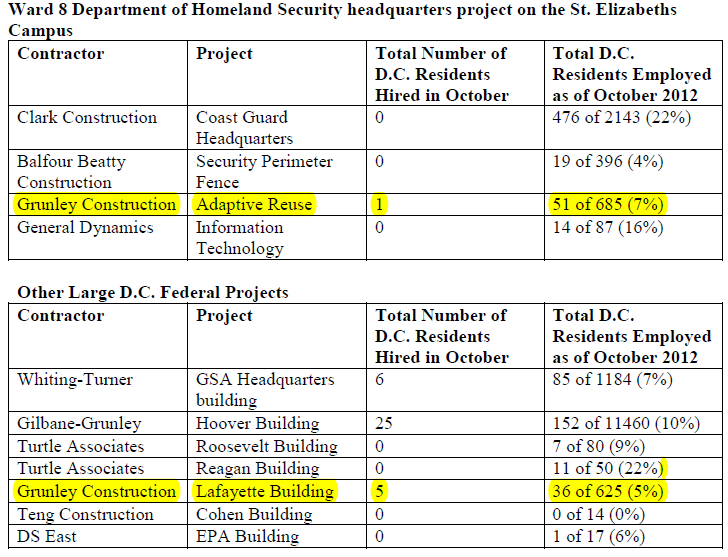Data Busts Myth that Project Labor Agreements Result in Increased Local Hiring
Special interest groups are in the business of convincing government officials and taxpayers there is a public benefit to anti-competitive and costly government-mandated project labor agreements (PLAs), which create jobs exclusively for unionized construction workers and steer huge public construction contracts primarily to well-connected unionized contractors.
In particular, proponents of government-mandated PLAs push an unsubstantiated claim that PLAs guarantee local hiring on construction projects funded by tax dollars. However, recent data acquired from certified payrolls from a number of large-scale federal construction projects in Washington, D.C., calls this claim into question. (Learn more about the local hire PLA myth here).

Union protestors promote PLAs by demanding “local hire” on a District of Columbia construction jobsite even though less than one out of 10 construction workers in D.C. belong to a union.
The office of Delegate Eleanor Holmes Norton (D-D.C.) recently highlighted the disappointing local hiring numbers on two large-scale federal construction projects subject to federal PLA mandates in her district.
According to a series of press releases from last October and December, local hiring on the only two federal PLA projects in Washington, D.C.—the U.S. General Services Administration’s (GSA) $57.4 million Adaptive Reuse contract for the DHS HQ at St. Elizabeth’s Hospital and the $55.6 million Lafayette Building contract (both contracts were won by Grunley Construction)—has been disappointing compared to a number of other local federal projects not subject to a government-mandated PLA or PLA preference.

Highlighted are PLA projects. The other projects are not subject to a government-mandated PLA or PLA preference and were bid using fair and open competition.
In fact, the local hiring on these two PLA projects has not improved much since Del. Holmes Norton held an August 2012 roundtable hearing on the lack of D.C. hiring for federal construction projects. (See press releases and local hire data here.)
Del. Norton’s data demonstrates there is little correlation between the use of PLA mandates or PLA preferences and an increase in local hiring on large federal projects in the Washington, D.C., construction market.
Del. Norton Supports PLAs
What’s interesting about this data is Del. Norton celebrated the use of PLAs on three large-scale GSA projects in Washington, D.C., following the implementation of a new controversial pilot program promoting the use of PLAs outlined in the GSA Public Buildings Service’s Aug. 11, 2009, Procurement Instructional Bulletin (PIB) 09-02.
The GSA issued its pro-PLA policy following President Obama’s Feb. 6, 2009, pro-PLA Executive Order 13502, which encourages federal agencies like the GSA to require PLAs on large-scale federal contracts exceeding $25 million in total costs on a project-by-project basis.
Check out Norton’s description of PLAs from her office’s Oct. 7, 2010, press release (pdf):
“Norton, who has jurisdiction over the GSA as chair of the House Subcommittee on Economic Development, Public Buildings and Emergency Management, has pushed for PLAs on federal projects because of their special advantage to taxpayers of on-time completion by skillfully trained workers at a predictable cost and for the hiring of local residents who can be hired on future projects.”
However, the truth is that the GSA’s experience with PLAs on large-scale federal projects in Washington, D.C., undermine Del. Norton’s and President Obama’s claim that PLA mandates advance economy and efficiency in federal contracting.
GSA’s Poor Experience with PLAs in Washington, D.C.
One of the GSA’s first PLA projects, the renovation of the agency’s headquarters at 1800 F St., suffered millions of dollars in increased costs and a 107-day delay as a result of a PLA. The prime contractor, a Whiting-Turner Walsh Joint Venture (JV), could not reach a finalized PLA with all of the local construction trade unions so the GSA told the JV to proceed with construction without a PLA (see related blog post here).
On the GSA’s Lafayette Building, the GSA and Grunley Construction agreed to a change order for $3.3 million to build the project with a PLA even though the contract had already been awarded without a PLA for $52.3 million.
Coupled with D.C.’s poor experience with government-mandated PLAs related to local hiring, quality, cost and timeliness on local, state and federal projects (see Wilson Bridge, D.C. Convention Center and Nationals Stadium documented here and here), it’s curious why lawmakers and taxpayers fall for pro-PLA propaganda.
PLA Myths Busted at D.C. Council Hearing
Luckily, there are public officials smart enough to see through the myths promoted by pro-PLA activists and lobbyists.
For example, the D.C. Council committees on Housing and Workforce Development and Government Operations held a joint hearing on June 30, 2010, to consider the District Resident Employment and Trade Stimulus Amendment Act of 2010 (Bill 18-650). This bill would require the use of anti-competitive and costly PLAs on all projects costing more than $200,000 that receive some form of support from the District.
One of the most important moments of this nearly nine-hour marathon hearing came at 2:12:40 in this video (here is a link to the hearing witness list), when Councilmember Mary Cheh (D-Ward 3) questions PLA proponents and spokespeople from construction trade unions about how local D.C. residents get jobs through union hiring halls.
Councilmember Cheh’s line of questioning prompted PLA proponent and construction trade union attorney Gerard Waites to expose the discriminatory nature of PLAs on local construction workers seeking employment through union hiring halls. This bill died in committee.
As Mr. Waites alluded to in his testimony, the real purpose of these anti-competitive and costly schemes is to help well-connected union contractors regain lost market share, create jobs exclusively for union members, push nonunion employees into joining unions, and direct an influx of cash and dues into union coffers.
However, the public record of poor performance of government-mandated PLAs lends truth to the adage that PLAs remain a union-backed solution in search of a problem. Hopefully continuous anecdotes, studies, data and hearings expose the truth about government-mandated project labor agreements in Washington, D.C. and other markets across the United States.












